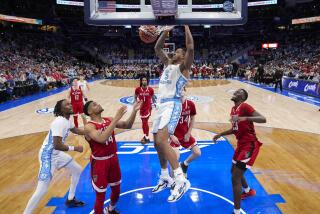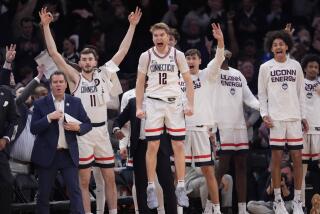Stanford Has an Easy Road to Final Four Appearance
All I can say after looking at the NCAA tournament brackets is that I’m happy for Mark Madsen.
The rookie from Stanford is the good-natured recipient of all kinds of abuse in the Laker locker room. But for the next two weeks, at least, he should be able to talk all the smack he wants because his alma mater has a golden path to the Final Four.
Stanford doesn’t even have to leave the state, with opening-round games at San Diego and the regional at the Arrowhead Pond. And the Cardinal has a very soft bracket in the West.
Stanford did itself a huge favor by retaining the No. 1 seeding in the West. Anything to avoid going East.
The East has champions of three major conferences: the Big Ten (Iowa), the Southeastern Conference (Kentucky) and the Big East (Boston College). And that’s just in USC’s half of the bracket.
UCLA faces a potential meeting with Atlantic Coast Conference champion Duke in the regional semifinals, which could send them home quickly. And sorry, Bruin fans, but what person who saw that classic Duke-Kentucky regional final in Philadelphia in 1992 wouldn’t want to see a rematch?
Sometimes it seems as though Duke is the only college basketball team that consistently recognizes the difference between good shots and bad shots. They’re especially tough when Mike Dunleavy Jr. is playing as well as he did this weekend. And you know Shane Battier won’t do anything stupid.
More bad news for Duke’s first two opponents: the subregional site is in North Carolina. The only thing that didn’t go in Duke’s favor is that their regional begins on Thursday instead of Friday. The Blue Devils could use the extra day of rest to heal Jason Williams and Carlos Boozer. Their ability to recoup from their injuries looks like the only question mark in Duke’s march to the championship game.
The Midwest regional looks ready for the taking by Arizona, a loaded team that’s peaking at the right time. The Wildcats are seeded second, in a regional that probably has the weakest No. 3 seeding in Mississippi. (It’s time that everybody recognizes Boston College, seeded third in the East). And Arizona split a pair of regular-season games against Illinois, the regional’s top-seeded team. The regional will be held in San Antonio, a very manageable trip for Arizona’s fans.
The South is the dumping ground for former No. 1 seeding contenders. Just a week ago, North Carolina, Florida and Michigan State had shots to be seeded first. Now they’re all in the South, all feeling a little bit miffed, and ready to stomp on any hopeful lower seeds.
Final Four picks: Duke, Stanford, North Carolina and Arizona.
Unfortunately, this year’s bracket rotation means Duke and Stanford would meet in the national semifinals, instead of the championship.
That’s just a matter of bad timing. Now what the Division I men’s basketball committee needs to do is find a way to restore some sense of geographic order to the tournament. The committee is so concerned with bracket balance and fulfilling the mythical “S curve” that it makes a mockery of the regional names--and blows the opportunity to create some regional rivalries.
Besides Stanford, only two other teams in the West regional come from schools West of the Mississippi: Brigham Young and Iowa State--and no one really considers Ames, Iowa, a Western town.
With three teams from the Beltway area (Maryland, Georgetown and George Mason) in the lower half of the West regional, it would make more sense to hold the first two rounds of that subregional in Washington’s MCI Center.
Instead, the same NCAA that tells us it can’t add more games to create a college football playoff because it would interfere with academics, will send those schools to Boise, Idaho.
That’s one side effect of admitting so many teams from major conferences. The selection committee tries to spread them around so they don’t meet in the first two rounds. I think they should group them together, in addition to some other area schools. One of the reasons the conference tournament games are so competitive is that you have teams that are so familiar with one another playing with more at stake. Meeting in the NCAA tournament would magnify that even further.
The tournament set up some good possible story lines by sending Jim Harrick to the same side of the draw as UCLA and Lefty Driesell’s Georgia State team to a potential second-round matchup against his former school, Maryland.
Missed opportunities by the committee: Denying Princeton Coach John Thompson III a chance to coach against his dad’s old team, Georgetown. And keeping Kansas away from North Carolina in what would have been one big Roy Williams reunion.
But the NCAA tournament, the greatest show in sports, has a way of developing its own stories and introducing us to new characters. It’s time to forget the talk of Ratings Percentage Index, strength of schedule and all of the bracket talk that goes with it. From here on out, there’s no such thing as a quality loss.
More to Read
Go beyond the scoreboard
Get the latest on L.A.'s teams in the daily Sports Report newsletter.
You may occasionally receive promotional content from the Los Angeles Times.










